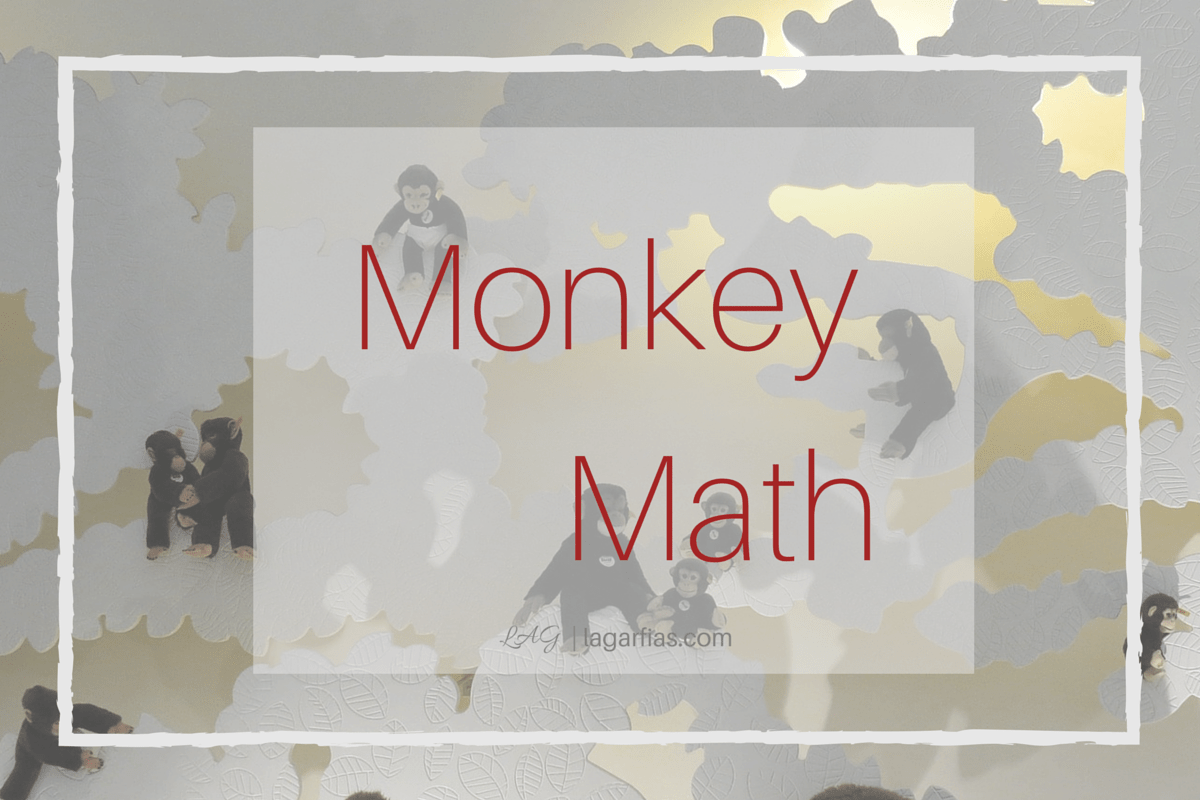
Yesterday, I ran an article I wrote for Home School Enrichment Magazine entitled “Too Young For Math? The How and Why of Early Math Education.” I wrote this article last year because of the numerous questions I receive from homeschooling mothers all over the country. Many mothers are confused by the propaganda of curriculum publishers and a few well-meaning yet misquoted homeschool resources. These moms become convinced by the various “experts” that teaching math is hard, that some (if not most) mathematical concepts are above the grasp of a child, and that encouraging a young child to study math is detrimental to his health. At times, it seems that life experience supports such claims, too; how many of us have tried to teach the multiplication table and realized that it is easier to beat ourselves repeatedly over the head with a brick? And when a child would rather cry than do another timed fact sheet, something within us seems to admit this way is not right. I would submit to you, friends, it is not math itself that is the enemy, but the way in which we have taken the joy out of exploring math. That is the purpose of my article; I wish all families would thrill to find God’s sustaining power and majesty in the wonder of His mathematical principles.
While preparing for that article, I relied on the advice of some of my favorite mathematicians. I talked to my oldest son quite a bit. He was nearly 12 then, and hopes to be an astrophysicist someday. He has a much better picture of math in his mind than I ever did, so I talked with him a lot about how he played and what he imagines. I also talked to my father, who taught me math from preAlgebra through Trigonometry, Calculus, college Statistics, and Physics. I sent him a rough draft of my article to see if my ideas were sound. And I still ask him math questions often.
I also sent a rough draft of my paper to my friend Karen Lagunowich. I met Karen years ago, back when she was still single and her now-husband Corey played Risk for hours with my husband in our first apartment. Karen and Corey have been married for eight years now, and Corey is a Control Systems Engineer, designing control systems for large telescopes and lasers. Karen holds a BS in Science Education and is a former teacher of Calculus and Biological Sciences. Now she home educates her two preschool-aged sons in Pennsylvania. I eagerly read her blog entries on how she teaches them “difficult math concepts” in literal ways using hands-on approaches according to their ability and curiosity. I find her work refreshing and inspiring. I wish I had taught my first children like she does. Here is repost of an article she wrote for us earlier, explaining how she teaches early math.
Monkey Math
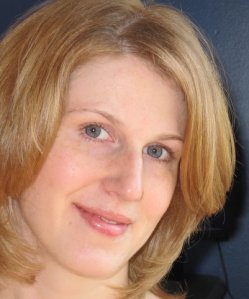 I am not a math educator nor am I an expert on how preschoolers learn. I am simply a mom who wants her children to learn as much about God’s world as they are able. I have two boys ages 3.5 and 2. I haven’t done any “formal” pre-schooling with them, but I do teach random things all throughout the day as their curiosity leads. The following stories are all things I have done with my eldest son…let’s just call him Monkey.
I am not a math educator nor am I an expert on how preschoolers learn. I am simply a mom who wants her children to learn as much about God’s world as they are able. I have two boys ages 3.5 and 2. I haven’t done any “formal” pre-schooling with them, but I do teach random things all throughout the day as their curiosity leads. The following stories are all things I have done with my eldest son…let’s just call him Monkey.
The grand majority of Monkey’s math learning is revolved around food (yes, he’s a typical boy). Adding to get more crackers and then eating crackers to subtract sure does make counting a lot more fun. Whenever I don’t mind how much he eats (within reason, of course) I ask him how much he would like. When we had strawberries for lunch the other day, I asked:
“How many would you like?”
“Five.”
And so I cut the stems off five strawberries and we counted them as I put them on his plate.
Last night after eating all his steak, beans, and rice he asked for more rice.
“How much would you like?”
“Lots and lots and lots.”
“I’m not sure how much that is. Can you use a number to tell me?”
“Hmmmm…five rice.”
“I don’t think five pieces of rice is very much. Are you sure?”
“Yes. I want five.”
“Ok. I’ll bring you five.”
I put five small scoops on his plate and then brought it to the table and set it out of his reach. Then I picked up a small bit and counted out five grains of rice and put those in front of him.
“One, two, three, four, five. There you go. Five grains of rice.”
He looked up at me and just smirked. Then picked up each grain of rice with his fingers and ate them. He knew he got what he asked for.
“Was five grains of rice a lot?”
“No.”
“How about five scoops of rice? Would you like five scoops?”
“Yes, please!”
I put his plate in front of him and he happily ate his five scoops of rice. Voila, a pre-school lesson in units and unit conversion. Five has been his “big” number lately. If he wants a lot of something he always asks for five.
He understands that five is more than three (his current age) so five is really what he is striving for. He is convinced that when he is five, he will be a big boy. Five is Monkey’s big number.
When you simply speak a number to a child, it is very abstract to them. So each time you relate a number to an object (unit) they better understand the true value of that number.
Lately when I ask him, “How much do you want?” I almost always expect to hear “five.” Each time I give him five of something he sees how much it is. He is learning that five goldfish is not nearly as satisfying as five strawberries and five pieces of rice isn’t even worth asking for. Along with learning quantity he is learning that the unit really makes a difference. And as a science teacher who was plagued with students’ lack of understanding when it came to units, this makes my heart smile. Five grains of rice is certainly not the same as five scoops of rice. If I continue to stress the difference in units now, maybe he won’t have such a difficult time when it comes to comparing 5 mL to 5 L when he’s older.
Math in the Kitchen

Both my boys love to help me cook in the kitchen. I’ll admit sometimes it is hard to let them “help” too often because of the extra time that it takes. They usually also learn a lesson in patience as each one takes a turn measuring and dumping ingredients, but one particular day Monkey woke up from his nap before his brother and we had some quality learning time together.
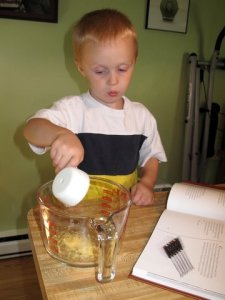 An Asian salad dressing was on the menu so there were mostly liquids. I changed my focus from the regular “scoop and dump” that we usually do. This time my goal was to get Monkey to read me the directions. His job was to read me the amount and I would tell him the name of the ingredient. (He can recognize numbers and letters, but can’t read words yet). His first task was to look at the ½ symbol in the book and then match it to the appropriate cup. This helped with both number recognition and matching symbols from two different objects. (Usually children’s matching games match identical cards, blocks, pieces etc…this was teaching him to match the text on a page to an actual object.)
An Asian salad dressing was on the menu so there were mostly liquids. I changed my focus from the regular “scoop and dump” that we usually do. This time my goal was to get Monkey to read me the directions. His job was to read me the amount and I would tell him the name of the ingredient. (He can recognize numbers and letters, but can’t read words yet). His first task was to look at the ½ symbol in the book and then match it to the appropriate cup. This helped with both number recognition and matching symbols from two different objects. (Usually children’s matching games match identical cards, blocks, pieces etc…this was teaching him to match the text on a page to an actual object.)
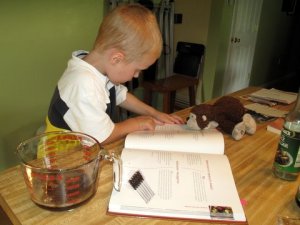 The other thing I focused on during this particular “cooking class” was keeping his place in the list while looking for the next ingredient. After measuring out ½ cup of vinegar I would tell him “We just measured ½ cup. Do you remember where that was on the list? Point to it for me.” After he found what we had just done I asked him to find what was next by moving his finger down one line. That went pretty well until we had several of the same measurements in a row and he kept getting lost.
The other thing I focused on during this particular “cooking class” was keeping his place in the list while looking for the next ingredient. After measuring out ½ cup of vinegar I would tell him “We just measured ½ cup. Do you remember where that was on the list? Point to it for me.” After he found what we had just done I asked him to find what was next by moving his finger down one line. That went pretty well until we had several of the same measurements in a row and he kept getting lost.
I also showed him the difference between ½ c and ½ t. The difference between a cup and a teaspoon is very different. Can you tell I’ve got this hang up over units? Our cooking session ended with a delicious tasting dressing, a few spills, and a Monkey who was more confident with using numbers in real life situations.

Math Food Game
The last food-related math activity I’d like to share with you is one we invented together. He has a number place-mat that we use now and then. When he asks for his usual five of something, I put the pile on the “five space” so he associates the written number 5 with the quantity. One day, I filled up a couple of different spaces and we made a game out of it. The following is a little video of our addition and subtraction game. It begins with Monkey’s little brother getting his snack before moving on to the real game.
[youtube=http://www.youtube.com/watch?v=v_eUsmJHQvk]
More Math Activities
Remember that pre-school math is not all about numbers. All my food examples had to do with quantities and simple arithmetic, but below you will find some other activities that focus on other areas of preschool math such as grouping, patterning, shape identification, and spatial concepts.
1. Count “seconds” while he races from here to there.
2. Quiz on the shapes of street signs as you ride down the road. Ask “What number highway are we getting on?” or “What is the speed limit?” as you approach the appropriate sign.
3. Finger-trace various routes on a map.
4. Give him only different sized cups and bowls as toys for the bath and encourage him to see which holds the most water by pouring from one container to the next.
5. Count stairs to teach your little one numerical order from 1-13. (There are 13 steps on a standard house staircase).
6. Take one pair of each family member’s shoes and have them organize them from smallest to largest.
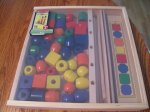 7. String patterns of colored pasta or beads. Monkey got this Melissa & Doug Bead Sequencing set for Christmas last year and we have found many different uses for it.
7. String patterns of colored pasta or beads. Monkey got this Melissa & Doug Bead Sequencing set for Christmas last year and we have found many different uses for it.
8. Count “division” of pizza slices or pieces of pie as you cut it from 1 to 2 to 4 to 8 slices. After each cut ask “Now how many slices are there?”
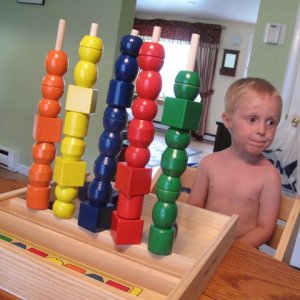 9. Learn to share snacks or toys by having him try to split things into equal piles. And then letting another other child choose the pile he wants.
9. Learn to share snacks or toys by having him try to split things into equal piles. And then letting another other child choose the pile he wants.
10. Load the dishwasher in an organized fashion, with plates, bowls, and cups sorted by type, lined up, and facing the same direction.
11. Sort a clean load of laundry into piles of tops and bottoms (or whatever kind of clothes you are folding) while mom folds and supervises.
12. Find matching pairs of socks.
13. Weigh produce at the grocery store. Don’t forget to put a unit with it! Most grocery scales also have kilogram measurements. This is a good introduction to how the same thing can weigh a “different” amount by measuring with a different system.
14. Play table games like Hi-Ho-Cherry-O, Thomas Numbers Game, Chutes & Ladders, Dominos, and Yahtzee Jr.
![]()
Karen enjoys teaching her munchkins, playing the trumpet, skydiving, and cheese. She lives with her husband and growing family in Pennsylvania. You can read more of Karen’s creative math teaching methods and get a glimpse into her life on Twighee’s Leaves. You can also ask her your own math questions by email .

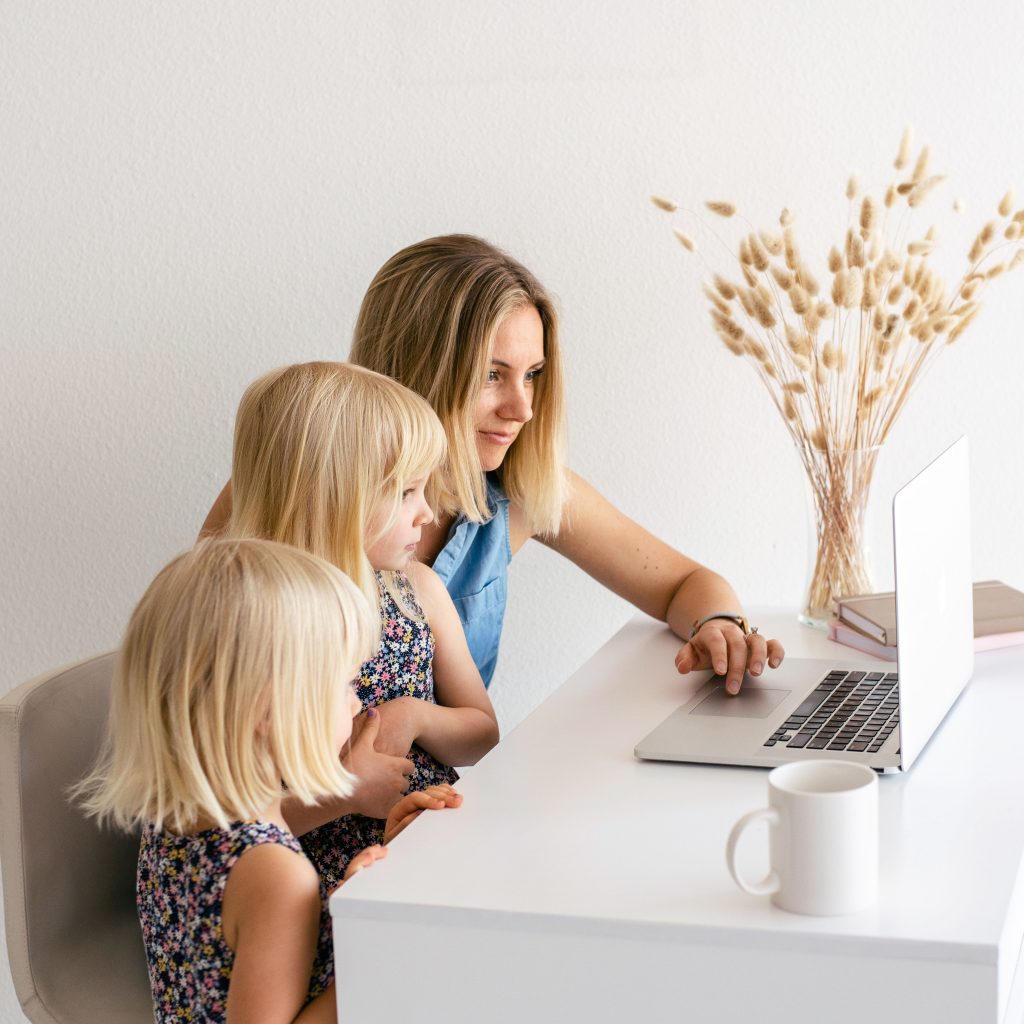
Wow! I love this article! A few things I naturally did with my daughter, but I didn’t think of it’s teaching her math! And, some GREAT creative ideas with the food! I especially like the recipe idea. I would not have thought of that because she cannot yet read, but I like the idea of matching the measurements. Thank you for sharing.
That is the beauty of exploring mathematics. During our daily lives, our children have so many opportunities to observe the natural patterns and rhythms God has created within His universe. Interrupting that scientific exploration is what turns them off of math and makes the whole process so difficult.
Karen is truly talented in seeing the deep math principles within our everyday existence and translating them so simply for young children. I am amazed, inspired, and instructed every time I read what she is doing.
Great article. We used A Beka math for our daughter, which worked well for her, but has been problematic for many others. Hannah would have loved this approach to math when she was starting out. While we did some of this, we certainly could have done more. Thankfully, she loves math today. I will certainly pass this along to those I know who are homeschooling their children of this age group. What a great way to learn and love mathematics!!